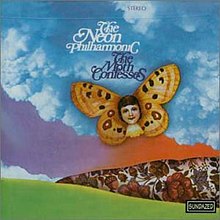| The Moth Confesses | ||||
|---|---|---|---|---|
 | ||||
| Studio album by | ||||
| Released | 1969 | |||
| Genre | Psychedelic pop[1] | |||
| Length | 31:32 | |||
| Label | Warner Bros./Seven Arts Sundazed Rhino Records | |||
| Producer | Don Gant Bob McCluskey Tupper Saussy | |||
| The Neon Philharmonic chronology | ||||
| ||||
| Review scores | |
|---|---|
| Source | Rating |
| Allmusic | Original Release link |
The Moth Confesses is the 1969 debut album by The Neon Philharmonic. Described as "A Phonograph Opera," it was inspired, according to the liner notes, by a production of Samuel Barber's Antony and Cleopatra, which Saussy attended after The New York Times claimed that it was a terrible opera, and wanted to see what a terrible opera looked like, which he surmised was its deliberate attempt to appeal to a one-time audience. In response, he conceived this album as a condensed opera, with a moth-like protagonist, focused on the "literary theme" of desperation. Saussy did not imagine it could be staged like Tommy, but offered it up as a challenge.[2]
"Brilliant Colors" and "Morning Girl" were both released as singles, while "The New Life Out There" was used to promote the record as a contemporary opera in radio advertisements. "Morning Girl" hit #17 on the Billboard Hot 100 chart and was later covered by The Lettermen. Shaun Cassidy covered "Morning Girl, Later" with a few tweaked lyrics (omitting the reference to "Catherine" which complicates the song, implying that the protagonist now has a wife or daughter) and titled it "Morning, Girl." The songs primarily cover the topic of striking out towards a new life when relationships fail for various reasons.
- ^ Anon (n.d.). "Psychedelic Pop". AllMusic.
- ^ Andy Zax. "A Conversation with Tupper Saussy." Liner notes, Brilliant Colors: The Complete Warner Recordings, p. 10.